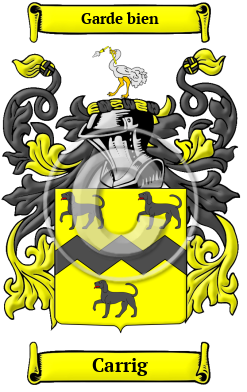| ![Show Contents]() Carrig History, Family Crest & Coats of Arms Carrig History, Family Crest & Coats of Arms
Etymology of CarrigWhat does the name Carrig mean? The ancient name Carrig was first used by the Strathclyde people of the Scottish/English Borderlands. It is derived from the personal name Craig. Thus, Carrig is a patronymic name, taken from the given name of the father or some other ancestor of the bearer. However, Carrig may also be of local origin, referring to those who lived in or near the place called Carrick in Ayrshire. 1 The name could have also been derived from the Gaelic, "carraig" meaning "rock." 2 Early Origins of the Carrig familyThe surname Carrig was first found in Ayrshire (Gaelic: Siorrachd Inbhir Àir), formerly a county in the southwestern Strathclyde region of Scotland, that today makes up the Council Areas of South, East, and North Ayrshire, and were known as 'the men of Carrick'. Duncan de Carrick (died 1250) was made the Mormaer (Earl) of Carrick by Scottish King Alexander I in 1186. He was a direct ancestor Robert the Bruce (Robert I), King of the Scots 1274-1329. Mestre Duncan de Carrike of county of Berewyke rendered homage to King Edward I of England in 1296. 1 Early History of the Carrig familyThis web page shows only a small excerpt of our Carrig research. Another 252 words (18 lines of text) covering the years 1224, 1296, 1320, 1360, 1370, 1371, 1372, 1380, 1429, 1554, 1606, 1665, 1716, 1717, 1779 and 1820 are included under the topic Early Carrig History in all our PDF Extended History products and printed products wherever possible. Carrig Spelling VariationsIn Medieval times, spelling and translation were not nearly so highly developed as today. They were generally carried out according to the sound and intuition of the bearer. For that reason spelling variations are extremely common among early Scottish names. Carrig has been spelled Carrick, Carick, Carich, Carrich, Karryck, Karrik, Karrick, Kerrich, Kerrick, Carrig, Carrigy, McCarrigy and many more. Early Notables of the Carrig familyJohn de Carrick (died c. 1380), a native of Carrick, Scotland, Chancellor of Scotland and Bishop-elect of Dunkeld (1370-1371.)
David Garrick (1717-1779), was an English actor, born on 19 Feb...
Another 28 words (2 lines of text) are included under the topic Early Carrig Notables in all our PDF Extended History products and printed products wherever possible. Migration of the Carrig family to IrelandSome of the Carrig family moved to Ireland, but this topic is not covered in this excerpt. More information about their life in Ireland is included in all our PDF Extended History products and printed products wherever possible.
| Carrig migration to Australia | + |
Carrig Settlers in Australia in the 19th Century- Henry Carrig, aged 31, who arrived in South Australia in 1851 aboard the ship "Marion" 3
- Mary A. Carrig, aged 23, a domestic servant, who arrived in South Australia in 1851 aboard the ship "Marion" 3
- Bridget Carrig, aged 22, a housemaid, who arrived in South Australia in 1854 aboard the ship "Emerald Isle" 4
- Honora Carrig, aged 20, a housemaid, who arrived in South Australia in 1854 aboard the ship "Emerald Isle" 4
- Kate Carrig, aged 18, a housemaid, who arrived in South Australia in 1854 aboard the ship "Emerald Isle" 4
- ... (More are available in all our PDF Extended History products and printed products wherever possible.)
| Contemporary Notables of the name Carrig (post 1700) | + |
- Kacey Carrig (b. 1992), American model
- John A. Carrig (b. 1952), American businessman, CEO and President of ConocoPhillips
The motto was originally a war cry or slogan. Mottoes first began to be shown with arms in the 14th and 15th centuries, but were not in general use until the 17th century. Thus the oldest coats of arms generally do not include a motto. Mottoes seldom form part of the grant of arms: Under most heraldic authorities, a motto is an optional component of the coat of arms, and can be added to or changed at will; many families have chosen not to display a motto.
Motto: Garde bien
Motto Translation: Watch well.
- Black, George F., The Surnames of Scotland Their Origin, Meaning and History. New York: New York Public Library, 1946. Print. (ISBN 0-87104-172-3)
- Bardsley, C.W, A Dictionary of English and Welsh Surnames: With Special American Instances. Wiltshire: Heraldry Today, 1901. Print. (ISBN 0-900455-44-6)
- State Records of South Australia. (Retrieved 2010, November 5) MARION 1851 - HER HISTORY. Retrieved http://www.slsa.sa.gov.au/BSA/1851Marion.htm
- South Australian Register Tuesday 17th January 1854. (Retrieved 2010, November 5) Emerald Isle 1854. Retrieved http://www.theshipslist.com/ships/australia/emeraldisle1854.shtml
 |

